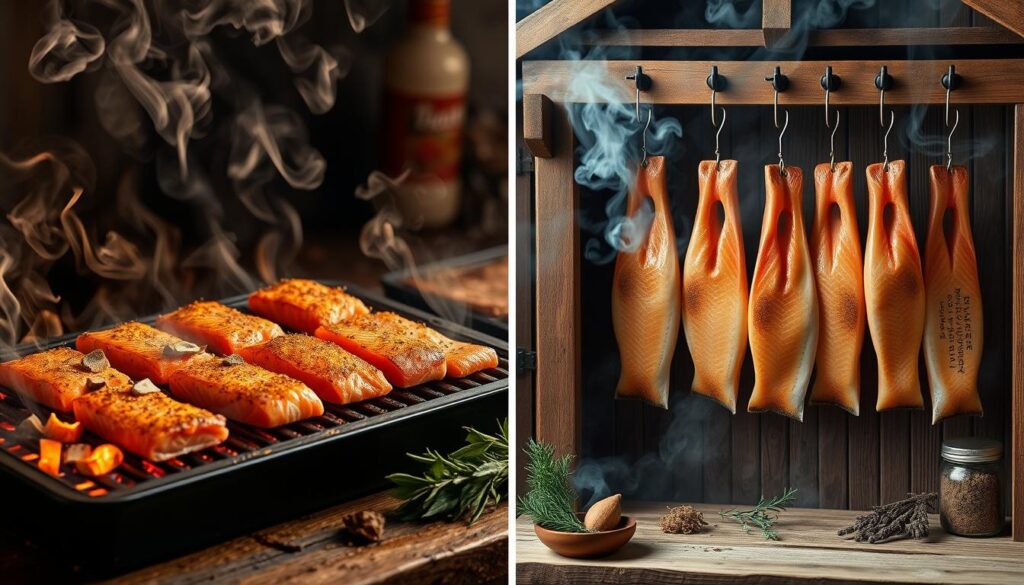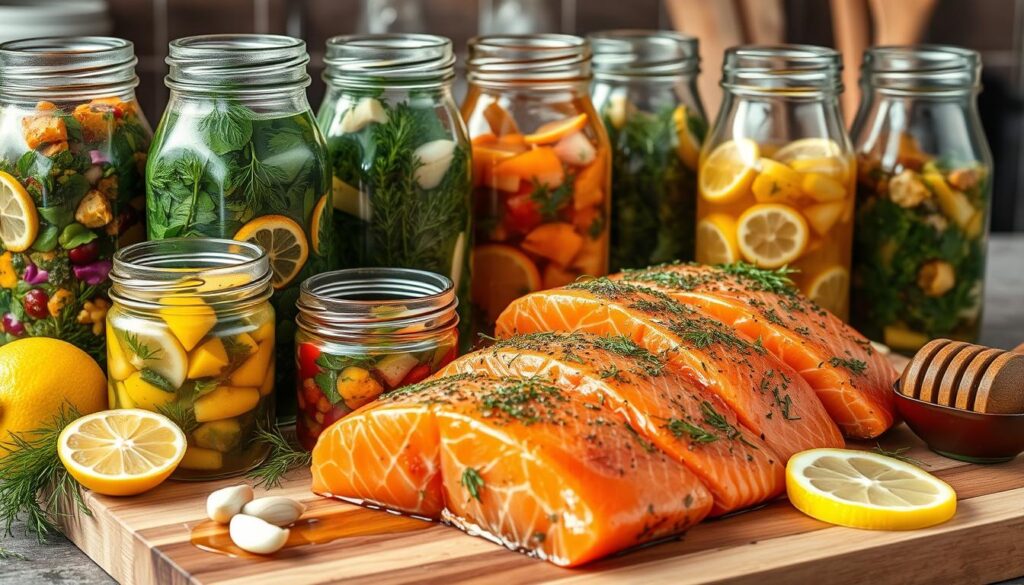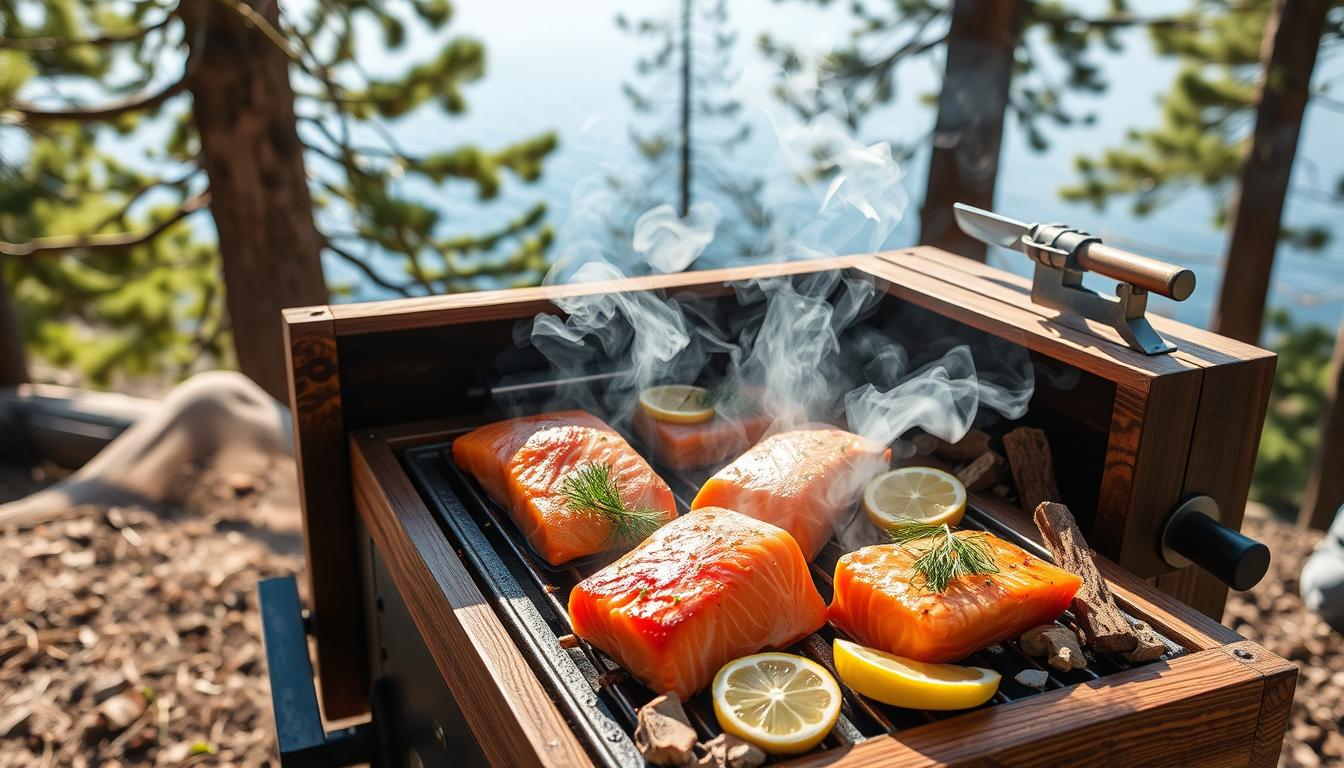Imagine standing in your backyard as the sun sets. The smell of smoked salmon fills the air. You can almost taste the smoky, savory flavors.
This isn’t just any salmon; it’s a masterpiece you’ve made. It brings family and friends together for a special meal. Learning to smoke salmon opens a world of flavors and memories.
Whether you’re a pro or just starting, this guide will help you. You’ll learn to make delicious smoked salmon at home. It’s like having a restaurant-quality dish in your own kitchen.
Key Takeaways
- Understanding the differences between hot and cold smoking can enhance your smoking skills.
- Choosing the right salmon variety enhances the flavors in your final dish.
- Utilizing proper brining techniques ensures a better-textured smoked salmon.
- Monitor internal temperatures to achieve perfect doneness in your salmon.
- The right wood chips can significantly impact the flavor profile of your smoked salmon.
- Storage and serving techniques can elevate your smoked salmon experience.
- Overcoming common smoking challenges leads to a better final product.
Understanding Smoked Salmon
Smoked salmon is a tasty treat that’s become very popular. It’s made by curing the fish and then smoking it. This method brings out the fish’s natural flavors. It makes cooking with smoked salmon a fun and exciting experience.
What Is Smoked Salmon?
Smoked salmon is salmon that’s been cured and then smoked. There are two ways to smoke it: hot or cold. Hot smoking cooks the fish, making it flaky and flavorful. Cold smoking keeps the fish soft and lets its subtle flavors come through. Both ways are great for different dishes and tastes.
Types of Smoked Salmon
There are a few main types of smoked salmon:
- Hot-Smoked Salmon – This is cooked at high temperatures. It’s firmer and perfect for hearty meals.
- Cold-Smoked Salmon – This is cured at low temperatures. It’s silky and great for fancy dishes.
Different salmon types like farm-raised Atlantic, King, and Coho also affect the taste. Each type has its own special qualities that make it unique.
Flavor Profiles and Uses
The taste of smoked salmon changes based on how it’s smoked and the wood used. Hot-smoked salmon is bold and rich. Cold-smoked salmon is milder and saltier. Both are great for many dishes:
- Bagels with cream cheese and smoked salmon;
- Salads with cold-smoked salmon;
- Pasta with hot-smoked salmon for a filling meal.
Smoked salmon is versatile and perfect for many recipes. Knowing about its different types and tastes can help you cook amazing dishes. It’s great for both casual and fancy meals.
| Type of Smoked Salmon | Texture | Flavor | Cooking Method |
|---|---|---|---|
| Hot-Smoked Salmon | Flaky | Rich and Bold | Cooked at 180-225°F |
| Cold-Smoked Salmon | Silky | Mild and Salty | Cured at 90°F |
Equipment You’ll Need for Smoking Salmon
To smoke salmon well, you need the right tools. There are many smoking salmon accessories to choose from. Electric, gas, and charcoal smokers each have their own benefits. Knowing these can help you get the best taste out of your smoked salmon.
Choosing the Right Smoker
When picking a smoker, think about a few things:
- Type: Electric smokers are easy to use and keep a steady temperature. Charcoal smokers give a traditional taste. Gas smokers heat up fast.
- Capacity: Make sure the smoker can hold as much salmon as you want to smoke.
- Temperature Control: Look for smokers with good temperature gauges. They should keep the temperature between 180°F and 225°F.
Essential Tools and Accessories
Along with your smoker, you’ll need some smoking salmon accessories:
- Meat Thermometer: This is key for checking the salmon’s temperature. It should be between 135°F and 140°F.
- Brining Containers: Use safe containers for your brine. A good mix is 1 gallon of water, 2 cups of brown sugar or honey, and 2 cups of table salt.
- Wire Racks: These help with air flow during smoking.
- Wood Chips: Alder wood is best for its mild taste. But apple and pecan can add unique flavors. Soaking wood chips for 30 minutes before use helps too.
Safety Equipment
Keeping your smoking area safe is important. Here are some safety tips:
- Protective Gloves: Wear disposable gloves when handling raw salmon and ingredients.
- Disinfecting Supplies: Keep your area clean with disinfectants.
- Fire Extinguisher: Always have one nearby when using heat-producing equipment.
| Type of Smoker | Advantages | Disadvantages |
|---|---|---|
| Electric | Consistent temperature control, easy to use | Limited flavor complexity compared to wood-based smokers |
| Gas | Quick set-up, easy temperature adjustments | May require more frequent fuel replacement |
| Charcoal | Rich flavor profiles, traditional method | Requires more monitoring and effort |
Selecting the Perfect Salmon
Choosing the right salmon is key for great smoked results. Each type has its own flavor, making some better for smoking than others. Here, you’ll learn which salmon is best for smoking and how to check if it’s fresh.
Best Salmon Varieties for Smoking
Two salmon types are top picks for smoking:
- Atlantic Salmon: It has a rich flavor and lots of oil, keeping it moist and tender.
- King Salmon (Chinook): With the most fat, it gives a buttery taste that’s amazing for smoking.
These are the best for smoking because they stay moist and taste great.
Freshness and Quality Indicators
Buying fresh salmon is crucial for the best taste. Look for these signs of freshness:
- Bright, Glistening Skin: Shiny and moist skin means it’s fresh.
- Firm Flesh: Press it gently; it should spring back.
- Fresh Smell: It should smell clean and briny, not fishy.
If you choose frozen salmon, get it from a reliable source. Check the thawed fish for the same quality signs as fresh salmon before smoking.
Preparing the Salmon for Smoking
Success in smoking salmon starts with proper preparation. This includes cleaning the fish, brining, and drying. Each step is crucial for enhancing flavor and texture, ensuring perfect smoked salmon.
Cleaning and Filleting
Before starting, clean and fillet the fish. Rinse the salmon under cold water to remove impurities. Use a sharp knife to remove scales and pin bones, ensuring a clean fillet.
Proper filleting greatly impacts the quality of smoked salmon.
Brining Techniques
Brining salmon before smoking is key for flavor and moisture. A good brine has 2 quarts of water, 1 cup of kosher salt, and 1 cup of brown sugar for sweetness. Let the salmon sit in the brine for at least 9 hours.
For larger pieces, like whole sides of salmon, aim for 24 hours. You can go up to 72 hours, but be careful not to over-brine.
Drying the Salmon
After brining, drying the salmon is crucial. It develops a pellicle, a sticky layer that helps the smoke stick better. Let the salmon dry for about 90 minutes, but no more than 2 hours.
Choosing Your Wood Chips for Smoking
The wood chips you choose are key to smoking salmon. They greatly affect the flavor. By picking the right wood, you can experiment with different tastes. Knowing the different woods helps you make choices based on what you like.
Popular Wood Choices
There are many wood chips that can make your smoked salmon better. Here are some popular ones and what they bring to the table:
- Alder: Alder is top for smoking salmon. It burns cool and slow, adding a light, buttery smoke. This smoke is sweet and complements the fish’s flavor well.
- Apple: Apple wood adds a hint of sweetness. It’s great for those who want a milder flavor.
- Pecan: Pecan wood has a smoky taste with a nutty twist. It burns hotter, so watch it closely to avoid overcooking.
- Maple: Maple wood balances sweetness and earthy notes. It’s like candied bacon, making the salmon taste better.
- Cherry: Cherry wood gives a light, sweet flavor. Mixing it with other woods adds depth to the smoke.
Flavor Impacts of Different Woods
Wood chips can change the taste of smoked salmon a lot. They affect not just the taste but also the cooking experience. Here’s how different woods change the flavor:
| Wood Type | Flavor Profile | Best Use |
|---|---|---|
| Alder | Light, buttery sweetness | Best for salmon |
| Apple | Subtle sweetness | Pork, chicken, cheeses |
| Pecan | Smoky, nutty | Pork, beef, chicken |
| Maple | Sweet, earthy | Bacon, ham, vegetables |
| Cherry | Light and sweet | Wide variety of foods |
Knowing how wood chips affect flavor lets you customize your smoking. Pick the right wood to bring out the best in your salmon. This way, every batch will be a treat to eat.
Smoking Techniques: Hot vs. Cold
Knowing the difference between hot and cold smoking salmon is key to getting the right taste and texture. Each method has its own benefits and needs special techniques. Learning about these smoking methods can improve your cooking skills.
Hot Smoking Explained
Hot smoking cooks salmon at higher temperatures, between 150°F and 180°F. This makes the salmon moist and flaky. The heat helps the proteins coagulate well.
The salmon is ready when it reaches an internal temperature of 145°F. It takes about 1.5 to 2 hours for small fillets. Thicker cuts can take up to 4 hours.
Cold Smoking Explained
Cold smoking uses lower temperatures, around 90°F. It cures the salmon without cooking it, making it silky smooth like lox. This method needs careful temperature control and takes longer.
The salmon stays below 90°F, showing it’s cured rather than cooked.
When to Use Each Method
Choosing between hot and cold smoking depends on what you want. Hot smoking is quick and flavorful, perfect for a flaky texture. Cold smoking is for a smooth texture, ideal for fancy dishes.
Think about time, texture, and flavor when deciding. Here are some key points:
- Time: Hot smoking is faster, cold smoking takes longer.
- Texture: Hot smoking gives flakiness, cold smoking gives silkiness.
- Flavor Depth: Both methods add unique flavors to your dish.

| Smoking Method | Temperature Range | Internal Temp When Done | Texture | Time Required |
|---|---|---|---|---|
| Hot Smoking | 150°F to 180°F | 145°F | Flaky and moist | 1.5 to 4 hours |
| Cold Smoking | Below 90°F | Not applicable | Soft and silky | Extended periods |
Knowing what you want will help you choose between hot and cold smoking. Both methods can enhance your salmon cooking skills.
Mastering the Smoking Process
Smoking salmon right is all about mastering certain techniques. This ensures the Smoke Salmon tastes great and feels just right. We’ll cover both hot and cold smoking methods. Remember, timing and temperature are key to a perfect smoke.
Step-by-Step Smoke Salmon Guide to Hot Smoking
Hot smoking adds deep flavors to salmon. Here’s how to do it right:
- Prepare the Brine: Mix 1 cup of brown sugar and ½ cup of kosher salt in 4 cups of water. Soak the salmon fillets for 6–8 hours.
- Dry the Salmon: Rinse the fillets in cold water and pat them dry with paper towels after brining.
- Create a Pellicle: Let the salmon air dry in the fridge for about 1 hour. This helps the smoke stick well.
- Preheat the Smoker: Set your smoker to keep a steady temperature between 175°F to 200°F.
- Smoking Process: Place the salmon on the racks and smoke for 2 to 4 hours. Aim for an internal temperature of 145°F.
Step-by-Step Guide to Cold Smoking
Cold smoking is a delicate process. It needs patience and careful temperature control.
- Brine Preparation: Use the same brine as hot smoking but soak for 12 hours for more flavor.
- Air-Drying: Let the salmon develop a pellicle in a cool, draft-free area. This may take hours.
- Set Up for Cold Smoking: Keep the smoking temperature low, between 60°F to 90°F. Never let it go above 90°F.
- Duration: Smoke the salmon for at least 12 hours to get full flavor.
Smoke Salmon Timing and Temperature Tips
Smoke Salmon Timing and temperature are crucial for smoking salmon. They help get the perfect texture.
| Salmon Type | Brine Duration | Smoking Duration | Ideal Temperature Range | Internal Cooking Temperature |
|---|---|---|---|---|
| King Salmon | 6–8 hours | 2–4 hours | 160°F–180°F | 145°F |
| Silver Salmon | 6–8 hours | 3–4 hours | 175°F–200°F | 145°F |
Enhancing Flavor with Marinades and Rubs
Adding marinades or rubs to smoked salmon can make your dish amazing. These methods bring new tastes that match the fish’s richness. They let you add your own flavor twist.
Popular Marinade Recipes
There are many marinades that can make your smoked salmon better. Here are a few favorites:
- Brown Sugar and Soy Sauce Marinade: A mix of sweet and savory.
- Lemon and Dill Marinade: Adds a fresh taste to the salmon.
- Maple-Roasted Garlic Marinade: Sweet and strong garlic flavors.
These marinades are easy to make and keep your salmon moist and tasty.
Dry Rub Options
Dry rubs are a simple yet effective choice. They give a crispy texture and bold flavor. Here’s what you need for a great dry rub:
- 2 tsp dried dill weed
- 1 tsp chili powder
- 1 tsp garlic powder
- 1 tsp sea salt
- 1 tsp black pepper (course grind)
This mix lets the salmon’s natural taste shine while adding a unique kick. Making the rub only takes 5 minutes, making it easy.

Storing and Serving Smoked Salmon
After making and enjoying smoked salmon, it’s important to store it right. This keeps it fresh and tasty. Follow these tips for storing smoked salmon and get creative with serving ideas.
Best Smoke Salmon Storage Practices
Storing smoked salmon correctly keeps its flavor and safety. Here are some key tips:
- Refrigerate unopened smoked salmon for up to two to three weeks.
- Opened smoked salmon lasts a week in the fridge, in an airtight container.
- Freezing extends its life to about three months. Use parchment paper between slices to prevent sticking.
- Keep it away from raw foods to avoid contamination.
Creative Serving Ideas
Smoked salmon is great for many dishes. Here are some ideas to try:
- Put it on charcuterie boards with cheeses, crackers, and fruits.
- Add it to salads for extra flavor, with greens, avocados, and citrus.
- Use it in pasta with cream sauces or olive oil for a rich taste.
- Make smoked salmon canapés with cream cheese, dill, and capers for fancy appetizers.
- Pair it with Gewürztraminer or Riesling for a perfect match.
Troubleshooting Common Smoking Issues
Smoking salmon can be a delightful experience, but sometimes problems arise. Knowing common issues helps you improve your smoking skills. Two big challenges are overcooked Smoke salmon and bitter flavors. With the right techniques, you can fix these problems easily.
Overcooked Smoke Salmon Solutions
Overcooking Smoke Salmon makes it dry and loses its flavor. To prevent this, keep an eye on the internal temperature. Aim for 130°F to 145°F. Cooking at 200°F helps keep it moist.
If you overcook it, don’t worry. Use sauces or marinades to add moisture and flavor. This way, you can still enjoy your dish.
Addressing Bitter Flavors
Bitter flavors in smoked salmon might come from over-smoking or strong wood chips. Use milder woods like apple or cherry for a softer flavor. Stick to the recommended 2 to 4 hours of smoking for the best taste.
By adjusting your smoking techniques, you can improve your salmon’s flavor. This makes your cooking journey even more rewarding.

